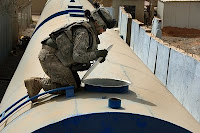-
Greening the U.S. Army: Report Calls Environment Critical to Post-Conflict Operations
December 11, 2008 By Rachel WeisshaarGreen Warriors: Army Environmental Considerations for Contingency Operations from Planning Through Post-Conflict (summary) is a comprehensive new RAND report on the U.S. Army’s environmental record in combat and peacekeeping operations. Green Warriors, which was commissioned by the Army Environmental Policy Institute, gives four main reasons why the Army should care about its environmental impacts, particularly in light of its lengthening overseas engagements:
- The environment can threaten soldiers’ health (through disease, polluted air or water, or exposure to hazardous substances);
- The military can harm its credibility with local populations by improperly disposing of waste or by damaging farmland or water supplies;
- Reconstruction projects that improve environmental conditions can foster support for the United States and the host-country government it supports, improving economic growth and security; and
- Environmental problems are often transboundary, and it is important to avoid allowing deficient U.S. environmental practices strain our relationships with other countries, especially given their importance to U.S. military activities.
Green Warriors emphasizes that environmental considerations are particularly significant during the post-conflict phase of operations:
[L]ocals often care deeply about the environment, which can be critical to their survival, livelihood, and well-being. Vital environmental issues can include access to clean drinking water, effective sewage systems, and viable farmland (see Box 1.1). Restoring or building these basic infrastructures is often essential for the economic and social development necessary for stability. To the extent that such projects improve cooperation with locals, they can lower security risks, improve intelligence, and speed reconstruction.
According to Green Warriors, the Army possesses extensive environmental policies and regulations for domestic and permanent foreign installations. Yet there are extremely few environmental regulations for contingency operations. The authors make the following recommendations:
- Improve environmental policy and guidance. The Army Strategy for the Environment, the Army’s new field manual on stability and reconstruction operations (New Security Beat coverage), and DoD’s 2005 decision to elevate post-conflict operations to the same level as combat operations (DoD Directive 3000.05) all provide a foundation upon which to build a standard DoD-wide environmental policy.
- Promote an environmental ethic and culture that extends to contingency operations. The Army must encourage soldiers and commanders to recognize and embrace the strategic benefits of good environmental stewardship.
- Incorporate environmental issues more extensively into planning. Commanders should receive high-quality environmental information and analysis, and risk assessments should be routinely undertaken.
- Improve environmental training and awareness. Commanders, soldiers, and non-combatant personnel should receive training on environmental issues both prior to and during their deployment. This training should include lessons learned from field experience.
- Expand environment-related investment. The Army should invest in personnel with the skills to implement a global environmental program and expand research and development to create technologies that would minimize environmental impacts of Army’s operations.
- Use the concept of sustainability as a guiding principle. The Army Strategy for the Environment calls sustainability the “keystone” of the Army’s environmental strategy, and the RAND report encourages the Army to expand this principle into all aspects of its contingency operations.
In a memo released with the report, Addison Davis IV, deputy assistant secretary of the Army for environment, safety, and occupational health, says that “the Army has the power to implement most” of the report’s recommendations. The question remains: Is the Army’s leadership willing to do so?
Photo: U.S. Army Spc. Gabriela Campuzano, a water purification specialist with the 94th Brigade Support Battalion, 4th Brigade Combat Team, 10th Mountain Division, inspects one of three water storage tanks at a water purification project site at the Baghdad Al Jadeeda Police Station in Baghdad, Iraq, June 12, 2008. The water site provides the local community with clean drinking water. Courtesy of Staff Sgt. Brian D. Lehnhardt, the U.S. Army, and Flickr.
 A Publication of the Stimson Center.
A Publication of the Stimson Center.




